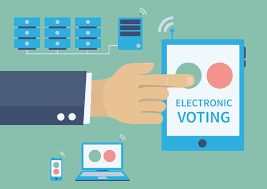Digital Voting service
Exploring the Future of Digital Voting: Enhancing Democracy through Technology
Introduction: In an era dominated by digital advancements, traditional voting methods have started to make way for more innovative and efficient alternatives. Electronic voting, remote voting, online voting, and e-voting are just a few examples of the technological transformations shaping the electoral landscape. With the promise of increased security, transparency, and accessibility, these digital voting methods are revolutionizing the way we participate in democracy. In this blog post, we will delve into the realm of digital voting and explore its various facets, including secure protocols, blockchain integration, mobile voting, cybersecurity considerations, and the broader concept of digital democracy. Electronic Voting: Electronic voting, also known as e-voting, eliminates the need for paper ballots by allowing voters to cast their votes electronically through specialized devices or secure online platforms. We will discuss the advantages of electronic voting, such as faster tabulation of results, reduced chances of human errors, and the potential for increased voter turnout.
Remote Voting: Remote voting enables citizens to exercise their right to vote from anywhere, breaking the geographical barriers that often limit participation. We will explore the technologies and mechanisms behind remote voting, highlighting its impact on voter accessibility, including for individuals living abroad or with physical limitations.  Election Commission's Remote Voting Pitch: Good on Paper, Gruelling in Reality
Election Commission's Remote Voting Pitch: Good on Paper, Gruelling in Reality
Online Voting: Online voting platforms provide a digital interface for voters to cast their ballots securely over the internet. We will discuss the benefits and challenges associated with online voting, such as ensuring secure authentication, protecting against cyber threats, and maintaining voter privacy.
-
Secure Voting:
Security is a critical aspect of digital voting systems. We will examine the robust security measures employed in electronic voting, including encryption techniques, multi-factor authentication, and secure transmission protocols, to safeguard the integrity of the voting process.
- Blockchain Voting:
Blockchain technology offers a decentralized and tamper-resistant platform for voting. We will explore how blockchain can enhance the transparency, auditability, and trustworthiness of digital voting systems, enabling verifiable and immutable records of votes.
Mobile Voting: With the increasing prevalence of smartphones, mobile voting has gained traction as a convenient and accessible option. We will delve into the functionalities and security considerations associated with mobile voting, including biometric authentication, encrypted communication, and secure app development.
Cybersecurity in Voting: The rise of digital voting brings forth new challenges in ensuring the cybersecurity of the electoral process. We will discuss the importance of robust cybersecurity measures, vulnerability assessments, and continuous monitoring to protect digital voting systems against hacking attempts and other cyber threats.
Digital Democracy: Digital voting is a cornerstone of the broader concept of digital democracy. We will explore how digital technologies can empower citizens, foster civic engagement, and provide avenues for direct participation in decision-making processes.
Transparent and Verifiable Voting: Digital voting systems strive to enhance transparency and verifiability. We will examine the mechanisms employed to ensure that votes are accurately recorded, counted, and can be audited or verified by relevant stakeholders.
Accessible Voting: Digital voting services aim to make the electoral process more inclusive and accessible for all citizens, regardless of their abilities or circumstances. We will discuss the importance of accessibility features, such as screen readers, alternative input methods, and language translation, in ensuring equal participation.
Biometric Voting: Biometric authentication techniques, such as fingerprint or facial recognition, can enhance the security and integrity of digital voting systems. We will explore the potential of biometric voting and the challenges associated with implementing such systems while safeguarding privacy and ensuring accuracy.
Encrypted Voting: Encryption plays a vital role in protecting the confidentiality and integrity of digital votes. We will delve into different encryption methods used in digital voting systems and how they contribute to secure and private voting experiences.
Auditable Voting: Auditing mechanisms are essential for ensuring the accuracy and legitimacy of digital voting results. We will discuss the importance of independent auditing, post-election audits, and transparency in the auditing process.
Trustworthy Voting: Building public trust is crucial for the widespread adoption of digital voting services. We will explore how transparency, open-source implementations, public education, and effective communication strategies can instill confidence in the integrity of digital voting systems.
Paperless Voting: Digital voting systems aim to reduce reliance on paper-based processes, offering more sustainable and environmentally friendly alternatives. We will discuss the environmental benefits of paperless voting and the challenges associated with transitioning from traditional paper ballots.
Voter Authentication: Verifying the identity and eligibility of voters is crucial in digital voting systems. We will explore different methods of voter authentication, such as cryptographic keys, unique voter identification codes, or biometric identification, and the importance of secure authentication protocols.
Digital Ballot: The digital ballot is the virtual equivalent of the traditional paper ballot. We will discuss the design, usability, and security considerations of digital ballots, including ensuring clarity, minimizing errors, and maintaining voter privacy.
Election Technology: Digital voting services encompass a wide range of technologies and innovations. We will explore the various components of election technology, including voting machines, software platforms, data management systems, and their role in shaping the future of democratic processes.
Conclusion: Digital voting services have the potential to transform the way we participate in elections, making the process more secure, accessible, and efficient. By embracing electronic voting, remote voting, online voting, and other emerging technologies, we can enhance democracy and empower citizens to exercise their right to vote in the digital age. However, it is crucial to address the security, privacy, and transparency challenges associated with digital voting to ensure the integrity of electoral processes and maintain public trust in the democratic system.
For more information WhatsApp on :- +917838888080



Comments
Post a Comment